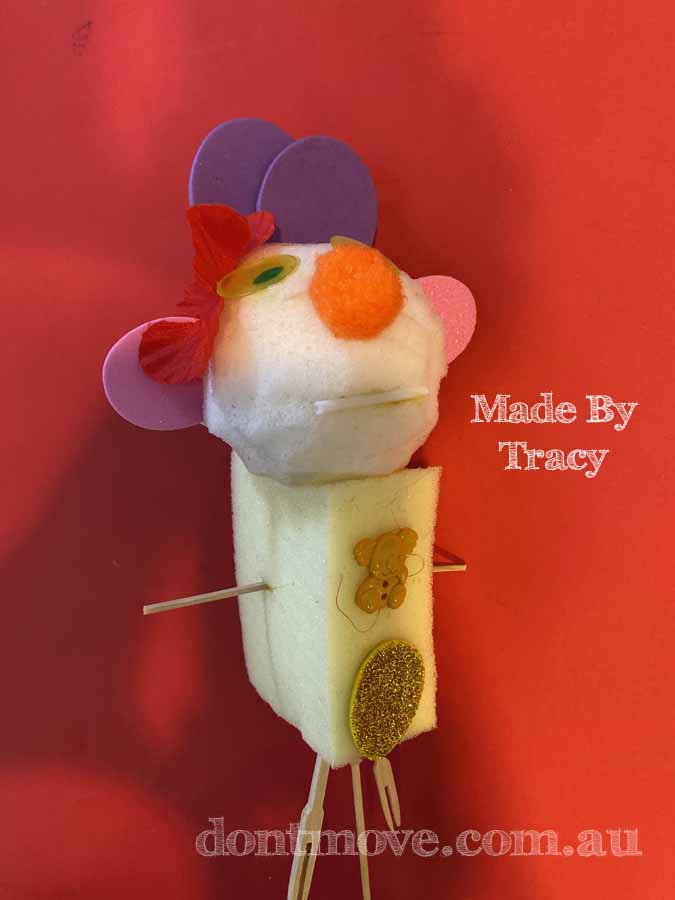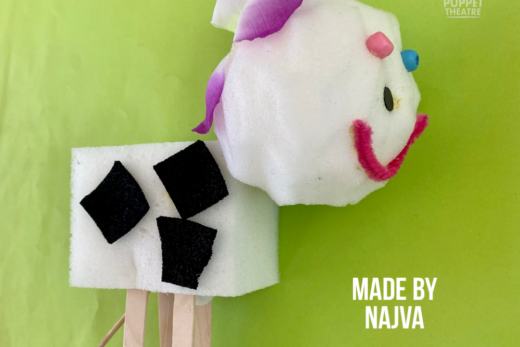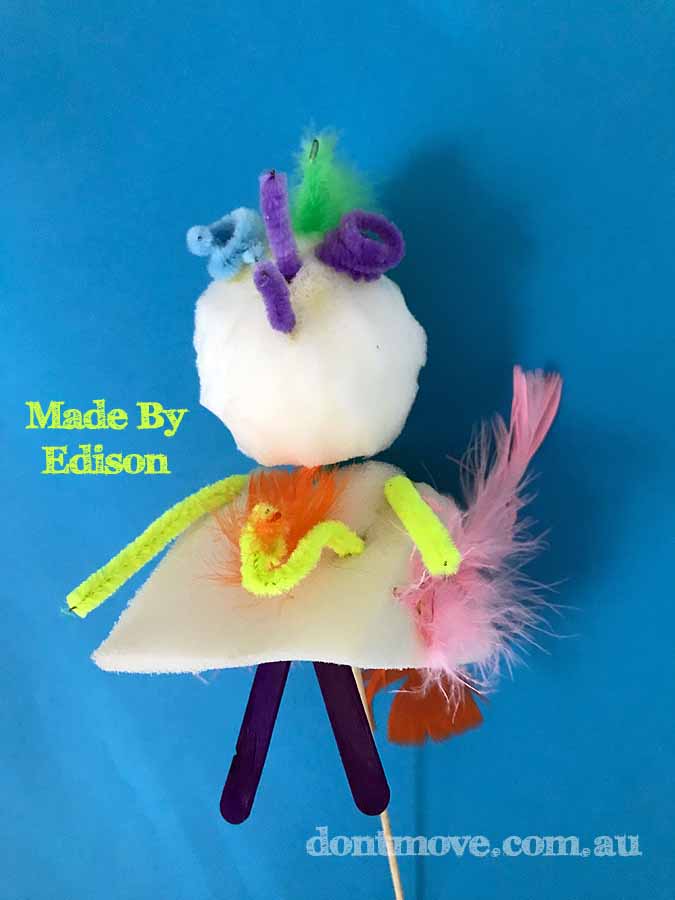The following are suggestions of ways “Don’t Move Puppet Theatre” could fit into the AusVELS Level 5.

 These are just a few suggestions, there would certainly be many more. Excerpts are taken directly from the Victorian Curriculum and Assessment Authority website here.
These are just a few suggestions, there would certainly be many more. Excerpts are taken directly from the Victorian Curriculum and Assessment Authority website here.
[See the other levels here: Foundation Level Level 1 Level 2 Level 3 Level 4 Level 6]

Both my show and workshop incursions fit easily into THE ARTS curriculum. Students are shown behind the scenes of my puppet theatre and learn a great deal about performance. The workshops also develop a hands on approach to creativity and art. Even my handouts after each visit encourage the children to be creative in making their own mini theatres from a ‘colouring-in’ poster.
“Students investigate a range of traditional and contemporary arts forms, styles, media, materials, equipment and technologies in the arts disciplines of Dance, Drama, Media, Music and Visual Arts, individually and in combination. They learn about ways to design, improvise, represent, interpret, make and present arts works that communicate feelings and their interests and understanding of themselves, their relationships and other people. For example in Drama, students role-play situations and events, sustaining role/character throughout their group or solo performance.They experiment with imaginative and innovative ways of generating ideas and manipulating arts elements, principles and/or conventions. Through exploring and responding, students begin to develop a vocabulary of appropriate arts language they can use to describe and discuss the content and structural qualities of their own and other people’s arts works. They begin to reflect on their responses to other people’s works and consider other’s perspectives when discussing arts works.”

In CIVICS AND CITIZENSHIP confidence in your own abilities and public speaking are developed. Drama has a large influence on this area of development. After seeing my show or making a puppets, students can be encouraged to perform their own works, including writing simple scripts or performing infron of their peers.

COMMUNICATION is important in all aspects of life. At the beginning of my show sessions I discuss how to be a good audience member, how to listen well and join in when appropriate. Much of this is covered in the communication topic as per below.
“Students use their understanding of communication conventions to communicate effectively with peers and to respond appropriately when they are part of an audience; for example, by waiting for the communication of others to be completed before responding. They practise listening attentively to identify and communicate main points to others. Students experience a variety of aural, written and visual communication forms in both formal and informal settings; for example electronic communication, performance and oral presentations. With support, they interpret these forms and begin to understand that their interpretation may be influenced by their own knowledge, values and beliefs, by persuasive devices such as emotive language, and by the opinions of others. When making meaning, students continue to develop skills in asking clarifying questions and seeking validation of their interpretations from their peers.”

My puppet making workshops easily fit into the DESIGN, CREATIVITY & TECHNOLOGY topic . Children learn to use different materials in new ways at the same time as being creative and letting their imaginations grow. My workshops are constantly used for this technology based topic to great result. Many of my workshop materials are recycled.
“Students contribute to the development of design briefs that include some limitations and specifications by posing questions about and identifying situations, problems, needs and opportunities for the creation of useful products and simple systems. They explore ideas and concepts about design, materials and systems, and consider how these can be combined in innovative ways to create solutions. Individually and in small teams, students develop possible solutions in response to design briefs, using simple mind maps, sketches, plans and annotated drawings, labelled diagrams models and flow charts. They increasingly use information and communications technology tools and techniques to research, develop and communicate ideas. They are encouraged to consciously select preferred options and explain why they have chosen them, referring to materials, function and aesthetics. Students learn to develop step-by-step plans for production and use a variety of production techniques, tools, materials and systems components to make products safely. They begin to record their progress using words and images. Students learn to analyse how products and systems function and what they look like, and discuss the meaning of quality in the context of design. “

My performances and their relevance to developing stories and scripts in ENGLISH are obvious. After seeing a show and behind the scenes, students are always inspired to go away and create their own shows for each other. I suggest how students can make their own theatres and I have seen this happen immediately when I return to the same school the following day.
“The English curriculum is built around the three interrelated strands of Language, Literature and Literacy. Teaching and learning programs should balance and integrate all three strands. Students listen to, read, view, interpret and evaluate spoken, written and multimodal texts in which the primary purpose is aesthetic, as well as texts designed to inform and persuade. These include various types of media texts including newspapers, film and digital texts, junior and early adolescent novels, poetry, non-fiction, and dramatic performances. They describe how events, characters and settings in texts are depicted and explain their own responses to them.”

My shows and workshops can encourage talk of the HISTORY of puppetry. The obvious benefits of drama can also help students be more confident in sharing their work on history through different forms of communication including oral, graphic, written and role play.

Many of my shows touch on aspects of INTERPERSONAL DEVELOPMENT. In particular, “The Wizard’s Tale”, “Three Animal Stories” and “Punch & Judy” partially deal with friendship, getting along and bullying being unacceptable. Other shows too have strong morals written within them without necessarily being the theme or learning focus of the shows. Theatre and drama in general also has avery positive effect on children’s confidence and personal character.
“Through discussion and activities such as role-play, they reflect on inclusion, belonging and tolerance. They consider how it feels to be excluded from a group. They identify examples of bullying in a range of contexts. They explore the impact of bullying on people’s sense of self-worth and are assisted to identify, discuss and use different strategies to reduce, avoid and resolve bullying.”
MATHEMATICS & SCIENCE are also involved in a hands on way during my workshops. I discuss three dimensional shapes as the students endeavour to cut out a spherical head for their puppet from a cube shaped piece of foam. Even watching the clock to wait three minutes for glue to dry can be a valuable learning experience.




